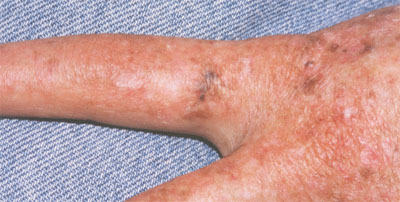|
|
|
Xeroderma pigmentosum
Xeroderma pigmentosum is an autosomal recessive disease characterized by photosensitivity, pigmentary changes, skin neoplasms, and premature aging of the skin.
It is attributable to abnormal DNA repair. Eight genes have been identified as important to the repair of ultraviolet light induced DNA damage. A defect in one or more of these eight genes can cause one of the clinical variants of xeroderma pigmentosum.
The patient's skin is normal at birth. By early childhood however manifestations of dermatoheliosis, or photoaging, becomes evident. By midteens, or earlier, the skin of a severely affected individual shows evidence of marked actinic damage, and skin tumors can begin to appear.
All of the manifestations of marked actinic damage that might be expected in the older, fair-skinned, sun exposed outdoor individual, can be seen in these children.
Death can occur secondary to cancer metastatic from the skin.
Treatment:
- Early and aggressive prevention of solar exposure is essential. Timing activity, proper clothing and broad spectrum sunscreens are parts of the program. Such sun avoidance must be rigorous.
- Close follow-up is indicated, with treatment as appropriate for skin cancers and pre-skin cancers as they arise.
- There is evolving medical evidence that long-term low dose treatment with systemic retinoids such as etretinate or isotretinoin can prevent or delay the development of skin tumors in patients already significantly actinically damaged but side effects are significant.

Back to Dermatology Glossary - X Index |
Back to Dermatology Glossary Index
|